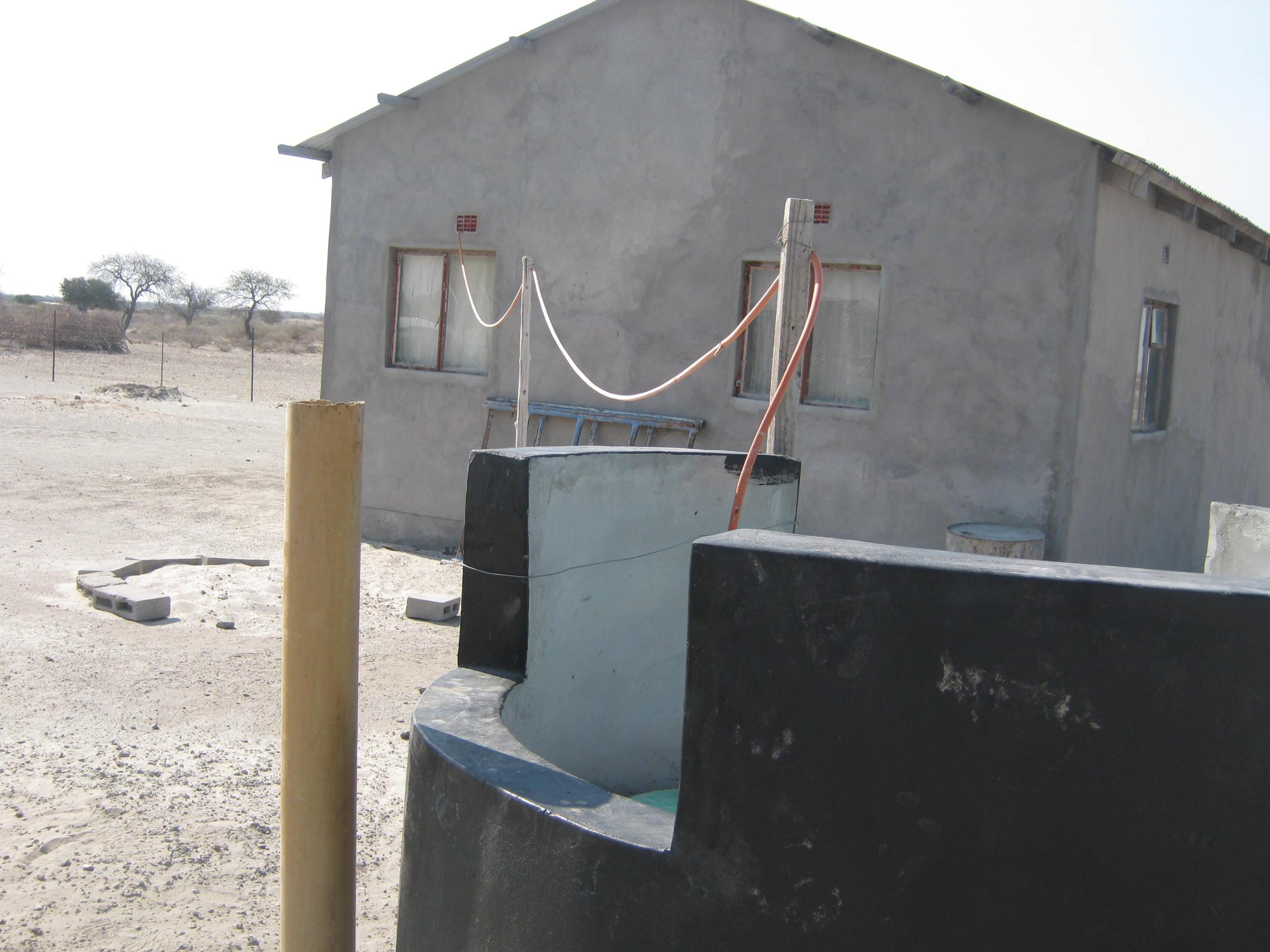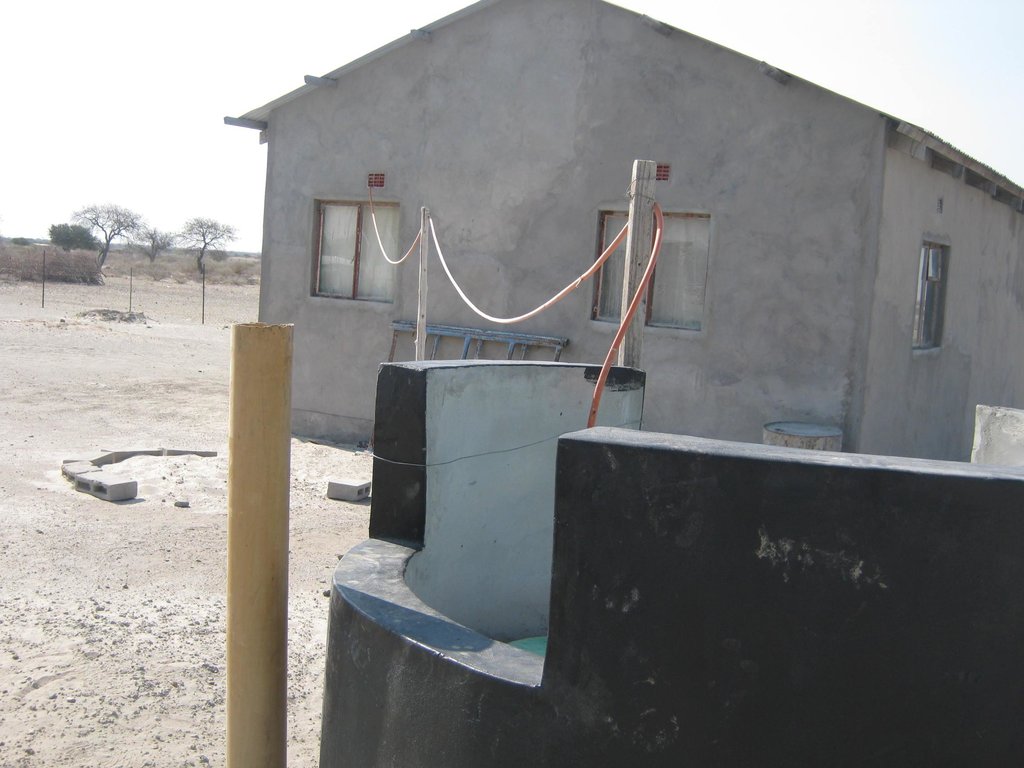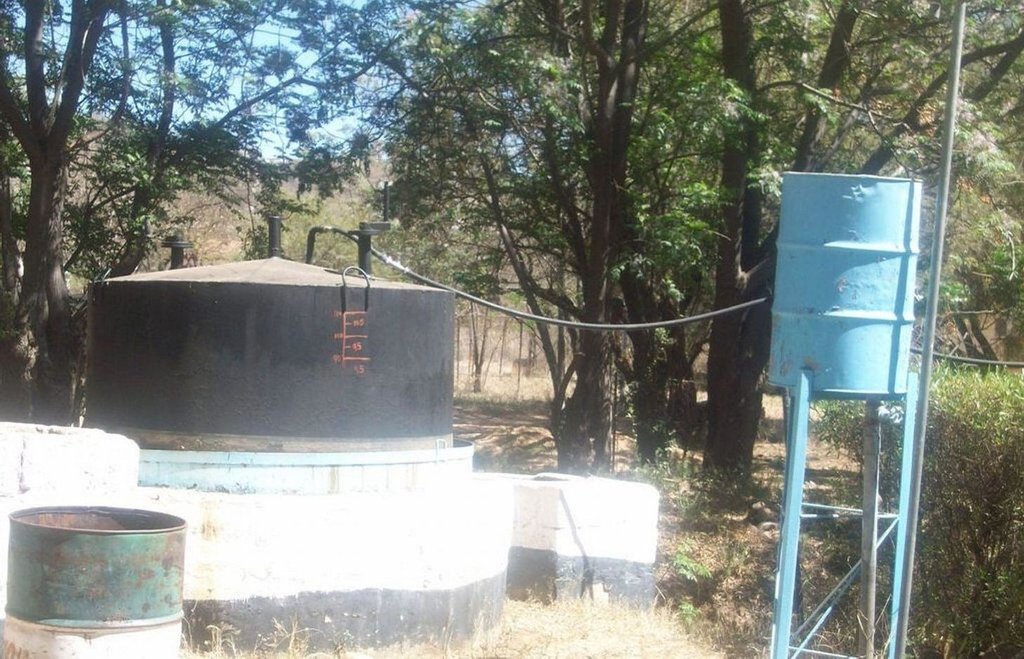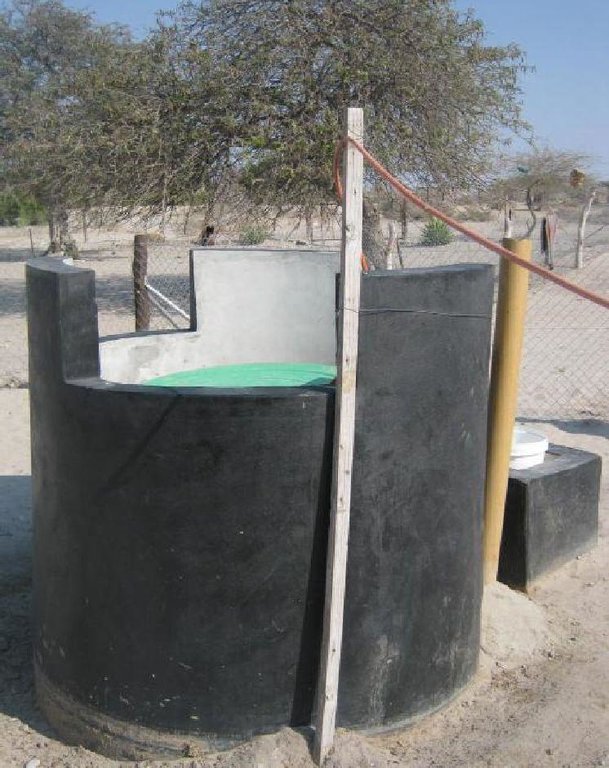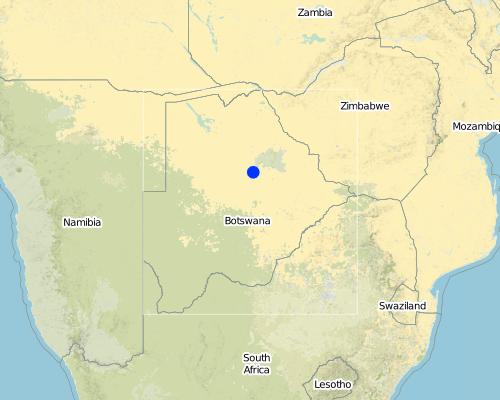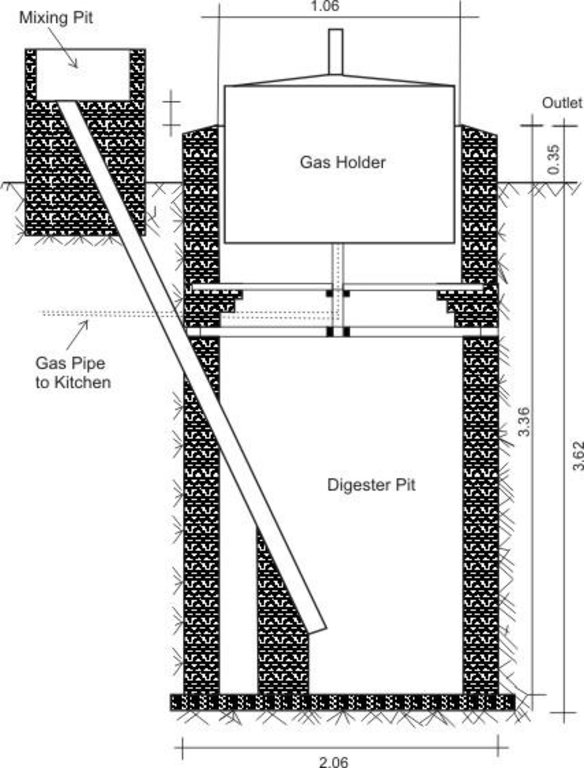Biogas [博茨瓦纳]
- 创建:
- 更新:
- 编制者: Sebego Reuben
- 编辑者: –
- 审查者: Fabian Ottiger
Gase ya Boloko (Setswana)
technologies_1521 - 博茨瓦纳
查看章节
全部展开 全部收起1. 一般信息
1.2 参与该技术评估和文件编制的资源人员和机构的联系方式
SLM专业人员:
Mulale Kutlwano
P/bag UB 00704 Gaborone
博茨瓦纳
SLM专业人员:
Chanda Raban
University of Botswana
P/bag UB 00704 Gaborone
博茨瓦纳
有助于对技术进行记录/评估的项目名称(如相关)
DESIRE (EU-DES!RE)有助于对技术进行记录/评估的机构名称(如相关)
University of Botswana (University of Botswana) - 博茨瓦纳1.3 关于使用通过WOCAT记录的数据的条件
(现场)数据是什么时候汇编的?:
19/02/2009
编制者和关键资源人员接受有关使用通过WOCAT记录数据的条件。:
是
2. SLM技术的说明
2.1 技术简介
技术定义:
Production of methane gas from cow-dung for use in house-hold cooking, heating and lighting in order to reduce fire wood demand
2.2 技术的详细说明
说明:
Biogas plant: The biogas plant can be constructed in several ways as long as it can provide a medium for the biological material be digested. Biogas is the name given to the gas that is produced during the decomposition of some organic waste specifically to produce methane gas. The gas is then captured in a storage tank (on site) to be used for household energy needs. In many parts of the world where this technology is used (including Botswana) the most common form of input material is cow dung making it more appropriate for rural environments.
Purpose of the Technology: Advantages: the technology offers two major advantages; first, at every level of use i.e. individual or institutional, savings in terms of energy is realized. The only costs that are borne are at installation, otherwise input of cow dung has a minimal cost of collection (if any at all). The second advantage is that there is reduced usage of fuel wood which translates into less cutting down of trees leading to reduced deforestation and degradation of land. A disadvantage is the initial investment which is significant for poor farmers.
Establishment / maintenance activities and inputs: Construction of the biogas plant: construction of the plant consists of three main chambers: namely, the Digester pit where all the microbiological reactions or decomposition of the material takes place. The digester has to be built to be air-tight with the released gas only escaping into the gas holder. The gas holder is connected to the digester by way of a pipe. Its main purpose is to collect all the gas that has been fermented. The mixing pit is the input chamber where the dung is mixed with water and fed into the digester. The amount and quality of water required for this is no constraint, even in this water stressed area. Construction the biogas plant has to be done according to specifications. A technical drawing of the plant is shown on page 3. The purpose of the technology is to use it for house-hold energy (for cooking, lighting and running appliances).
Natural / human environment: In Botswana the technology was introduced by the Rural Industries Innovation Center which is a government funded research institution. Despite the existence of this company for many years, the uptake has been very low due to poor marketing and extension services and lack of financial assistance to poor farmers.
Biogas is suitable either for a farm, cattle post or rural setting where the inputs (cow dung) are easily available. But there are possibilities of experimenting with other bio-degradable materials in major centres where cow dung is not readily available.
2.3 技术照片
2.5 已应用该技术的、本评估所涵盖的国家/地区/地点
国家:
博茨瓦纳
区域/州/省:
Southern District
有关地点的进一步说明:
Kanye village
Map
×2.6 实施日期
如果不知道确切的年份,请说明大概的日期:
- 10-50年前
2.7 技术介绍
详细说明该技术是如何引入的:
- 通过项目/外部干预
注释(项目类型等):
The technology is promoted by a government funded NGO, but has its origins outside the country
3. SLM技术的分类
3.1 该技术的主要目的
- 减少、预防、恢复土地退化
- 保护生态系统
- 创造有益的经济影响
3.2 应用该技术的当前土地利用类型

混合(作物/放牧/树木),包括农林
- 农林牧业
主要产品/服务:
Major cash crop seasonal cropping:
Major food crop seasonal cropping:
Major other crops seasonal cropping:
Main products semi-nomadism / pastoralism: Beef cattle, goats, sheep, donkeys, chicken
Main products ranching: Beef cattle
Forest products and services: fuelwood, fruits and nuts, grazing / browsing
注释:
Major land use problems (compiler’s opinion): Overgrazing of the commons, droughts, saline water and over-harvesting of fuelwood for cooking, heating leading to deforestation and land degradation
Major land use problems (land users’ perception): Overgrazing of the commons, droughts, saline water and over-harvesting of fuelwood for cooking, heating leading to deforestation and land degradation.
Grazingland comments: Biogass technology is not applied in the Boteti area at the moment, only at DESIRE test site.
Selective felling of (semi-) natural forests: specific tree species are felled for fuelwood even though people are supposed to take only fallen-dead wood
Type of cropping system and major crops comments: Mixed cropping is the traditional practice but government extension advice promotes monocropping which the majority find expensive and risky.
Type of grazing system comments: Biogass technology is not applied in the Boteti area at the moment, only at DESIRE test site.
Constraints of settlement / urban
3.3 有关土地利用的更多信息
该技术所应用土地的供水:
- 雨养
注释:
Water supply: Also post-flooding
每年的生长季节数:
- 1
具体说明:
Longest growing period in days: 179 Longest growing period from month to month: Oct - Mar
牲畜密度(如相关):
1-10 LU /km2
3.4 该技术所属的SLM组
- 节能技术
3.5 技术传播
注释:
Total area covered by the SLM Technology is 0 m2.
This technology is basically on a point location, even though it is to benefit a wider area in terms of conservation
3.6 包含该技术的可持续土地管理措施

结构措施
- S11:其它

管理措施
- M2:改变管理/强度级别
注释:
Main measures: management measures
3.7 该技术强调的主要土地退化类型

生物性退化
- Bc:植被覆盖的减少
- Bs:质量和物种组成/多样性的下降
注释:
Main type of degradation addressed: Bc: reduction of vegetation cover, Bs: quality and species composition /diversity decline
Main causes of degradation: deforestation / removal of natural vegetation (incl. forest fires) (harvesting of fuelwood for cooking, sometimes live trees are harvested.), land tenure (Area is communal grazing land)
Secondary causes of degradation: over-exploitation of vegetation for domestic use (Trees are cut for bush fences), droughts (The study area is prone to droughts), poverty / wealth ((lack of alternative livelihood sources))
3.8 防止、减少或恢复土地退化
具体数量名该技术与土地退化有关的目标:
- 修复/恢复严重退化的土地
注释:
Secondary goals: prevention of land degradation, mitigation / reduction of land degradation
4. 技术规范、实施活动、投入和成本
4.1 该技术的技术图纸
4.2 技术规范/技术图纸说明
The diagram shows the technical layout of a biogas plant; showing the position of the main components: Digester, Gas holder, Mixing pit, and outlet. Cow dung & or kitchen waste (except bones) is mixed with water to form a sludge. This sludge is fed into the digester pit where decomposition and fermentation takes place. As the sludge ferments, methane gas is produced. Methane is a combustible gas and can therefore be used for cooking and lighting. Specially designed gas stoves and lanterns may be required as the gas would not be purified and hence ‚thicker‘ than commercially produced gasses. However, the design can include a water filled pipe bend (u shaped) between the gas holder and outlet pipe. The water in this pipe would help to purify the gas before it is fed to the household appliances. The gas holder tank floats in water, through which the gas bubbles escape and methane gas collects into the floating tank. An outlet through which decomposed material leaves the plant is necessary. Old sludge would float and be removed through this opening (Diagram drawn by G. Koorutwe, Department of Environmental Science, University of Botswana).
Location: Mopipi. Boteti Sub-District
Date: 05/10/11 (revised)
Technical knowledge required for field staff / advisors: high (Skilled technician is needed for installation)
Technical knowledge required for land users: moderate
Main technical functions: reduction of wood exploitation
Secondary technical functions: promotion of vegetation species and varieties (quality, eg palatable fodder), enhancement of tree growth
Structural measure: Digestion pit
Depth of ditches/pits/dams (m): 3.38
Width of ditches/pits/dams (m): 2.06
Structural measure: Gas holder
Depth of ditches/pits/dams (m): 2
Width of ditches/pits/dams (m): 1.6
Construction material (other): bricks, pipes, cement, iron sheets
Change of land use practices / intensity level: Use of biogass for cooking would lead to reduced cutting of wood for cooking
4.3 有关投入和成本计算的一般信息
其它/国家货币(具体说明):
Pula
注明美元与当地货币的汇率(如相关):1美元=:
6.5
注明雇用劳工的每日平均工资成本:
1.08
4.4 技术建立活动
| 活动 | 措施类型 | 时间 | |
|---|---|---|---|
| 1. | Construction | 管理 | N/A |
4.5 技术建立所需要的费用和投入
| 对投入进行具体说明 | 单位 | 数量 | 单位成本 | 每项投入的总成本 | 土地使用者承担的成本% | |
|---|---|---|---|---|---|---|
| 劳动力 | Labour | Tank | 1.0 | 198.0 | 198.0 | 100.0 |
| 设备 | Tank | Tank | 1.0 | 615.0 | 615.0 | 100.0 |
| 设备 | Bricks | Tank | 1.0 | 77.0 | 77.0 | 100.0 |
| 设备 | Cement | Tank | 1.0 | 123.0 | 123.0 | 100.0 |
| 设备 | Plumbing material | Tank | 1.0 | 154.0 | 154.0 | 100.0 |
| 施工材料 | Earth | Tank | 1.0 | 31.0 | 31.0 | 100.0 |
| 技术建立所需总成本 | 1198.0 | |||||
注释:
Duration of establishment phase: 0.5 month(s)
4.6 维护/经常性活动
| 活动 | 措施类型 | 时间/频率 | |
|---|---|---|---|
| 1. | Filling up with cow dung and water | 管理 | 1 Day |
4.7 维护/经常性活动所需要的费用和投入(每年)
| 对投入进行具体说明 | 单位 | 数量 | 单位成本 | 每项投入的总成本 | 土地使用者承担的成本% | |
|---|---|---|---|---|---|---|
| 设备 | Cow dung | Tank | 1.0 | 33.0 | 33.0 | 100.0 |
| 技术维护所需总成本 | 33.0 | |||||
注释:
Costs were calculated for labour and material based on the real cost of construction at the Mopipi Site.
4.8 影响成本的最重要因素
描述影响成本的最决定性因素:
Material, labour and equipment used in construction are the most determining factors affecting the costs (installation cost is US$ 1198).
5. 自然和人文环境
5.1 气候
年降雨量
- < 250毫米
- 251-500毫米
- 501-750毫米
- 751-1,000毫米
- 1,001-1,500毫米
- 1,501-2,000毫米
- 2,001-3,000毫米
- 3,001-4,000毫米
- > 4,000毫米
有关降雨的规范/注释:
Seasonal summer rains, approx six months dry (LPG = 75-179)
农业气候带
- 半干旱
Thermal climate class: subtropics. Sub-tropical climate. Semi-arid with dry winters (LPG=75-179 days).
5.2 地形
平均坡度:
- 水平(0-2%)
- 缓降(3-5%)
- 平缓(6-10%)
- 滚坡(11-15%)
- 崎岖(16-30%)
- 陡峭(31-60%)
- 非常陡峭(>60%)
地形:
- 高原/平原
- 山脊
- 山坡
- 山地斜坡
- 麓坡
- 谷底
垂直分布带:
- 0-100 m a.s.l.
- 101-500 m a.s.l.
- 501-1,000 m a.s.l.
- 1,001-1,500 m a.s.l.
- 1,501-2,000 m a.s.l.
- 2,001-2,500 m a.s.l.
- 2,501-3,000 m a.s.l.
- 3,001-4,000 m a.s.l.
- > 4,000 m a.s.l.
关于地形的注释和进一步规范:
Altitudinal zone: 501-1000 m a.s.l. (Part of the Makgadikgadi basin)
Slopes on average: Flat (ranked 1, mainly low lying land of lucrustrine (pans) formation) and gentle (ranked 2, gently sloping (plains))
5.3 土壤
平均土层深度:
- 非常浅(0-20厘米)
- 浅(21-50厘米)
- 中等深度(51-80厘米)
- 深(81-120厘米)
- 非常深(> 120厘米)
土壤质地(表土):
- 粗粒/轻(砂质)
- 细粒/重质(粘土)
表土有机质:
- 中(1-3%)
- 低(<1%)
如有可能,附上完整的土壤描述或具体说明可用的信息,例如土壤类型、土壤酸碱度、阳离子交换能力、氮、盐度等。:
Soil depth on average: Shallow (ranked 1, generally soils are 40cm deep, underneath is a calcrete layer at about 40cm deep) and deep (ranked 2, some sandy area away from pans e.g. the Gidikwe Ridge )
Soil texture: Coarse/light (ranked 1, away from pans/river/flood plain = main soil type) and fine/heavy (ranked 2, sticky when wet in the depression)
Soil fertility: Low (ranked 1, sandy areas (Arenosols)) and medium (ranked 2, in flood plains of the Boteti river)
Topsoil organic matter: Low (ranked 1, low on sandy areas/soils) and topsoil organic matter (ranked 2, on the flood plains for molapo farming)
Soil drainage/infiltration: Good (ranked 1, very good on sandy soils) and medium (ranked 2, flood plains are medium)
Soil water storage capacity: Very low (ranked 1, on sandy soils) and medium (ranked 2, on flood plains)
5.4 水资源可用性和质量
地下水位表:
> 50米
地表水的可用性:
匮乏/没有
水质(未处理):
不良饮用水(需要处理)
关于水质和水量的注释和进一步规范:
Ground water table: >50m (ranked 1, for Boreholes) and 5-50 m (ranked 2, wells in the Boteti River bed)
Availability of surface water: poor/none (dry season-unreliable river flow/rainfall)
Water quality (untreated): Poor drinking water (treatement required, salty water in most areas, ranked 1) and unusable (sometimes too salty even for livestock consumption, ranked 2)
5.5 生物多样性
物种多样性:
- 高
关于生物多样性的注释和进一步规范:
Biodiversity: High (several game reserves (protected areas) nearby, ranked 1) and low (grazing areas with arable agriculture, ranked 2)
5.6 应用该技术的土地使用者的特征
非农收入:
- 低于全部收入的10%
相对财富水平:
- 平均水平
- 非常丰富
个人或集体:
- 个人/家庭
机械化水平:
- 畜力牵引
性别:
- 女人
- 男人
说明土地使用者的其他有关特征:
Land users applying the Technology are mainly Leaders / privileged
Difference in the involvement of women and men: There is no difference, as this is mainly a family thing or institutioanal like in schools and community halls
Population density: < 10 persons/km2
Annual population growth: 2% - 3%
10% of the land users are very rich and own 50% of the land (Cattle farmers).
60% of the land users are average wealthy and own 30% of the land (Most inhabitants).
30% of the land users are poor and own 20% of the land (Subsistance farm).
Off-farm income specification: Saves money for buying commercial gas and electric power. Helps conserve the forests. Limited off-farm income opportunities for everyone including non-adopters of the technology.
Level of mechanization: Animal traction (mostly donkeys for draught power)
Market orientation of annual cropping production system: Mixed (subsistence/commercial) Could be used/produced for domestic and commercial purposes.
Market orientation of grazing land production system: Subsistence and commercial/market
Market orientation of forest production system: Mixed (subsistence/commercial) in both cases use of biogas is approppriate
5.7 应用该技术的土地使用者拥有或租用的平均土地面积
- < 0.5 公顷
- 0.5-1 公顷
- 1-2 公顷
- 2-5公顷
- 5-15公顷
- 15-50公顷
- 50-100公顷
- 100-500公顷
- 500-1,000公顷
- 1,000-10,000公顷
- > 10,000公顷
这被认为是小规模、中规模还是大规模的(参照当地实际情况)?:
- 大规模的
注释:
Average area of land owned or leased by land users applying the Technology on grazing land
1000-10000 ha (ranked 1, cattle farmers in ranches and cattle posts)
15-50 ha (ranked 2, subsistence farmers)
Average area of land owned or leased by land users applying the Technology on cropland:
50-100 ha (ranked 1)
2-5 ha (ranked 2, on average)
5.8 土地所有权、土地使用权和水使用权
土地所有权:
- 社区/村庄
- 个人,未命名
土地使用权:
- 自由进入(无组织)
- 个人
用水权:
- 社区(有组织)
- 个人
注释:
The SLM can be used by anybody - not specified to any group. Dual grazing rights is a problem (private ranchers can also use the commons).
5.9 进入服务和基础设施的通道
健康:
- 贫瘠
- 适度的
- 好
教育:
- 贫瘠
- 适度的
- 好
技术援助:
- 贫瘠
- 适度的
- 好
就业(例如非农):
- 贫瘠
- 适度的
- 好
市场:
- 贫瘠
- 适度的
- 好
能源:
- 贫瘠
- 适度的
- 好
道路和交通:
- 贫瘠
- 适度的
- 好
饮用水和卫生设施:
- 贫瘠
- 适度的
- 好
金融服务:
- 贫瘠
- 适度的
- 好
6. 影响和结论性说明
6.1 该技术的现场影响
社会经济效应
生产
作物生产
注释/具体说明:
Assuming large scale removal of dung, there could be reduction in animal manure available for crop production
能源生产
收入和成本
农业投入费用
注释/具体说明:
As farmers would have to purchase fertilizer as animal manure becomes scarce
工作量
注释/具体说明:
With biogas no labour for fuelwood collection. Time and effort previously used for firewood collection is freed
社会文化影响
SLM/土地退化知识
冲突缓解
注释/具体说明:
Future conflict over fuelwood resources would be averted. In case of no ownership of cattle.
社会经济弱势群体的情况
注释/具体说明:
Less demand on the time and labour of women and the girl child who are the main collecters of fuelwood
Gender related issues
注释/具体说明:
Where taboos exist for women harvesting dung from kraals (livestock enclosure); this could constrain adoption along gender lines
Improved livelihoods and human well-being
注释/具体说明:
Provides cheaper and alternative source of energy. Reduces workload for fuelwood collection for women and the girl child.
生态影响
水循环/径流
水量
注释/具体说明:
Due to reduced plant cover
土壤
土壤覆盖层
注释/具体说明:
More trees certaily provides soil cover. But problems possible when plant cover is reduced as a result of less manure
养分循环/补给
注释/具体说明:
Reduced soil fertility with distance from water points/kraals
盐度
土壤有机物/地下C
注释/具体说明:
Due to redused animal manure
生物多样性:植被、动物
生物量/地上C
注释/具体说明:
Trees would have more density or cover
植物多样性
注释/具体说明:
Wood collectors target specific species
减少气候和灾害风险
碳和温室气体的排放
注释/具体说明:
Large scale adoption of biogas production may introduce air pollution. Also unpleasent smell around the village.
其它生态影响
Concentration of nutrients (dung)
注释/具体说明:
Cow dung will be reduce around water points and kraals
6.2 该技术的场外影响已经显现
水资源可用性
旱季稳定可靠的水流
地下水/河流污染
缓冲/过滤能力
风力搬运沉积物
对邻近农田的破坏
6.3 技术对渐变气候以及与气候相关的极端情况/灾害的暴露和敏感性(土地使用者认为的极端情况/灾害)
渐变气候
渐变气候
| 季节 | 气候变化/极端天气的类型 | 该技术是如何应对的? | |
|---|---|---|---|
| 年温度 | 增加 | 好 |
气候有关的极端情况(灾害)
气象灾害
| 该技术是如何应对的? | |
|---|---|
| 局地暴雨 | 好 |
| 局地风暴 | 好 |
气候灾害
| 该技术是如何应对的? | |
|---|---|
| 干旱 | 好 |
水文灾害
| 该技术是如何应对的? | |
|---|---|
| 比较和缓的(河道)洪水 | 好 |
其他气候相关的后果
其他气候相关的后果
| 该技术是如何应对的? | |
|---|---|
| 缩短生长期 | 好 |
| temperature decrease | 不好 |
注释:
Biogas technology may be limited under extreme cold conditions whereby fermentation may be limited by cold temperatures.
6.4 成本效益分析
技术收益与技术建立成本相比如何(从土地使用者的角度看)?
短期回报:
消极
长期回报:
积极
技术收益与技术维护成本/经常性成本相比如何(从土地使用者的角度看)?
短期回报:
积极
长期回报:
积极
注释:
Very costly to set up, if no government aid. It is however very good for long term water provision.
6.5 技术采用
如若可行,进行量化(住户数量和/或覆盖面积):
10
注释:
1% of land user families have adopted the Technology with external material support
10 land user families have adopted the Technology with external material support
Comments on acceptance with external material support: A very insignificant number of individual farmers have used this technology
Comments on spontaneous adoption: The technology has mostly been used where the Research institution has installed in farmers' properties. Only in very few instances around the country have individuals installed it for themselves.
There is a little trend towards spontaneous adoption of the Technology
Comments on adoption trend: There seems to be very little marketing of biogas in the country
6.7 该技术的优点/长处/机会
| 土地使用者眼中的长处/优势/机会 |
|---|
|
Problems of diminishing firewood species are reduced. How can they be sustained / enhanced? Because it is not every or all species that is used for firewood, the targeted species are quickly diminished |
|
Cost of getting firewood is reduced How can they be sustained / enhanced? Distance to wood collection places are ever increasing hence users have to buy from truck or donkey cart owners |
|
More time is freed How can they be sustained / enhanced? This especially applies to children (of school going age) in that they would have more time for their home works. |
| 编制者或其他关键资源人员认为的长处/优势/机会 |
|---|
|
Low maintenance and inputs are required for this technology How can they be sustained / enhanced? There is need for promotion of the technology |
|
The structures to be put in place are very basic How can they be sustained / enhanced? There is need for the government to subsidize farmers in installing biogas plants, especially in the rual areas. |
|
Good for rural households where firewood is used extensively. How can they be sustained / enhanced? Improve income of rural families so that they could afford the technology |
6.8 技术的弱点/缺点/风险及其克服方法
| 土地使用者认为的弱点/缺点/风险 | 如何克服它们? |
|---|---|
| Too expensive for poor farmers to adopt without assistance | Donor/government subsidies |
7. 参考和链接
7.2 参考可用出版物
标题、作者、年份、ISBN:
Brown, V. J., 2006. BIOGAS: A Bright Idea for Africa. Environ Health Perspectives. 114(5), pp. A300–A303.
可以从哪里获得?成本如何?
internet
标题、作者、年份、ISBN:
Dayal, M., Vimal, O.P., Singh, K.K., 1989. Biomass gasification in India — DNES activities. Biomass, Volume 18, issues 3-4,pp. 197-204
可以从哪里获得?成本如何?
http://www.ganesha.co.uk/Articles/Biogas%20Technology%20in%20India.htm
链接和模块
全部展开 全部收起链接
无链接
模块
无模块


